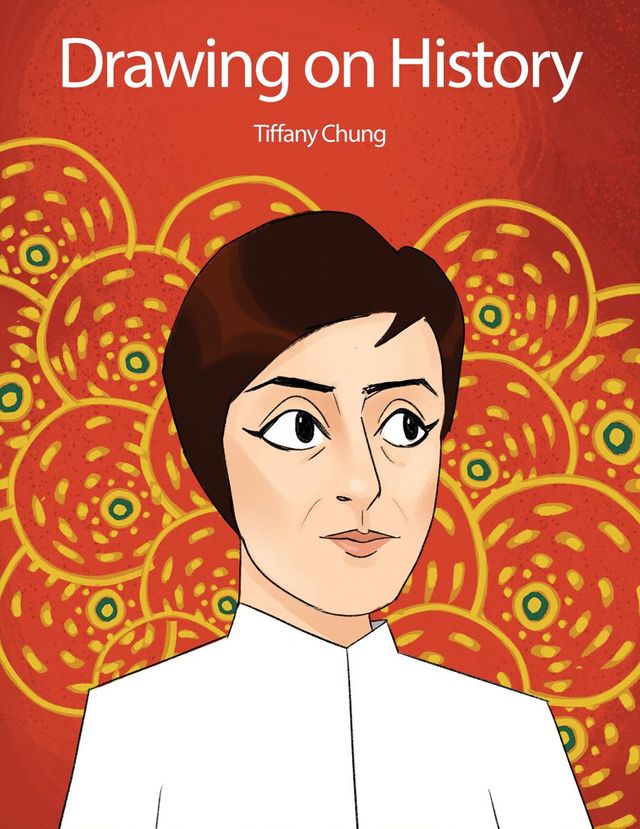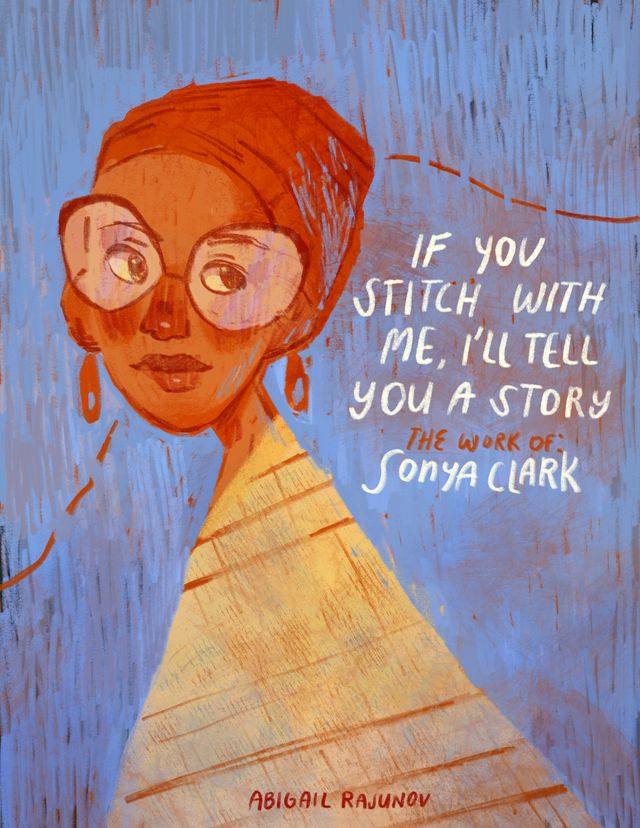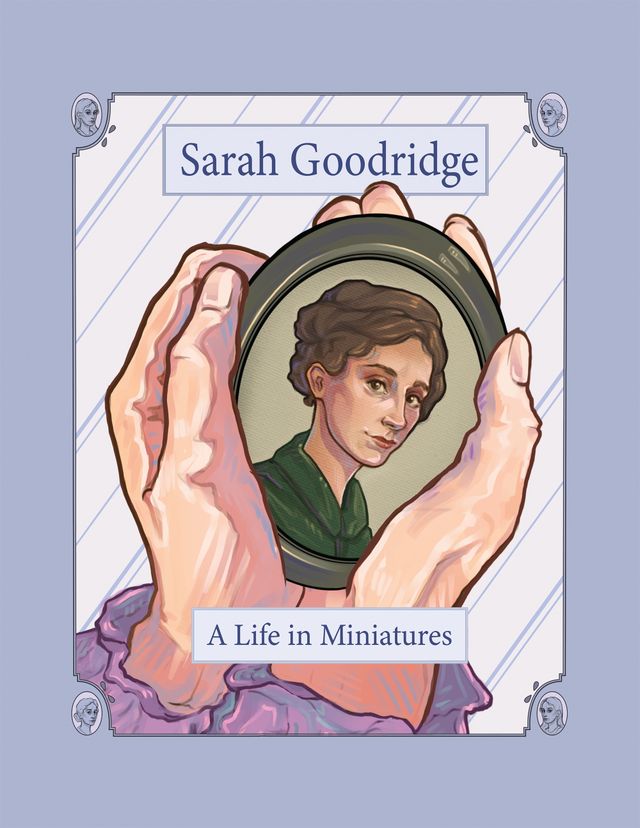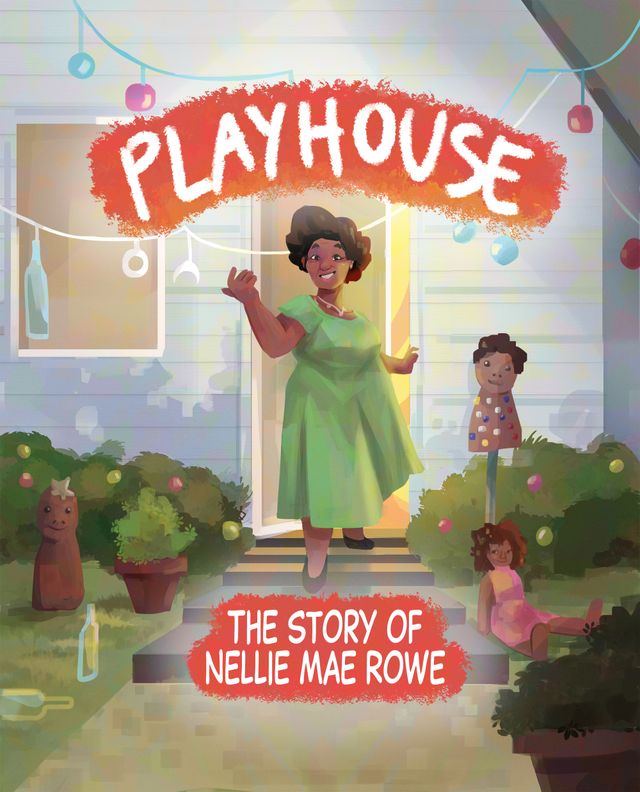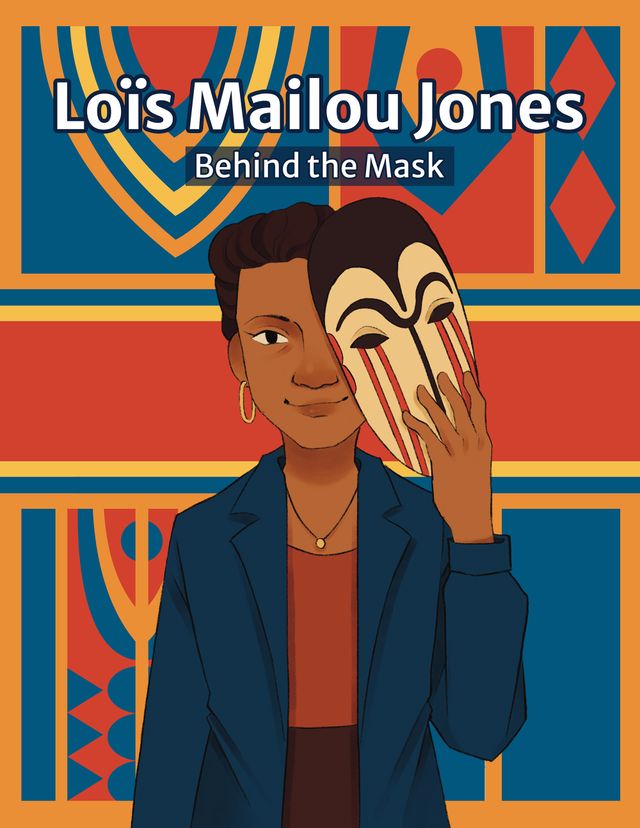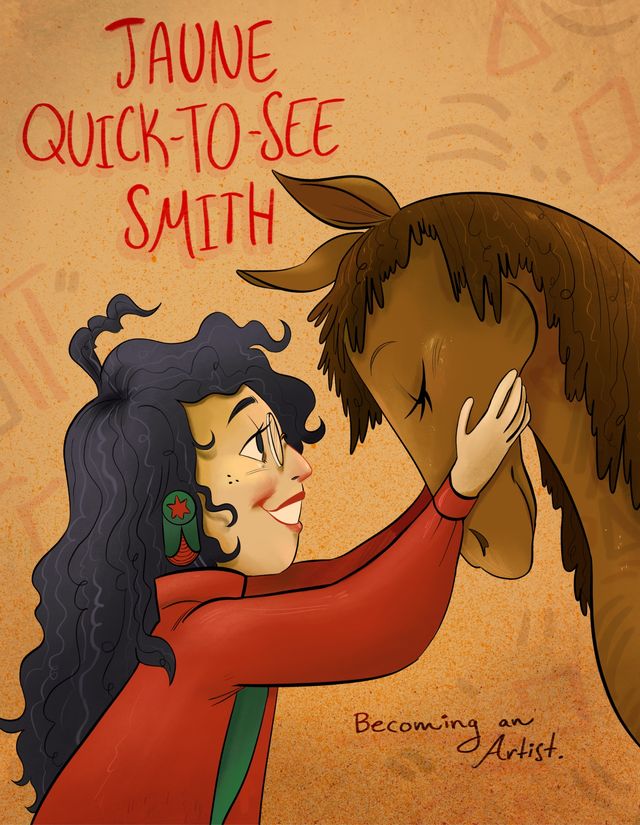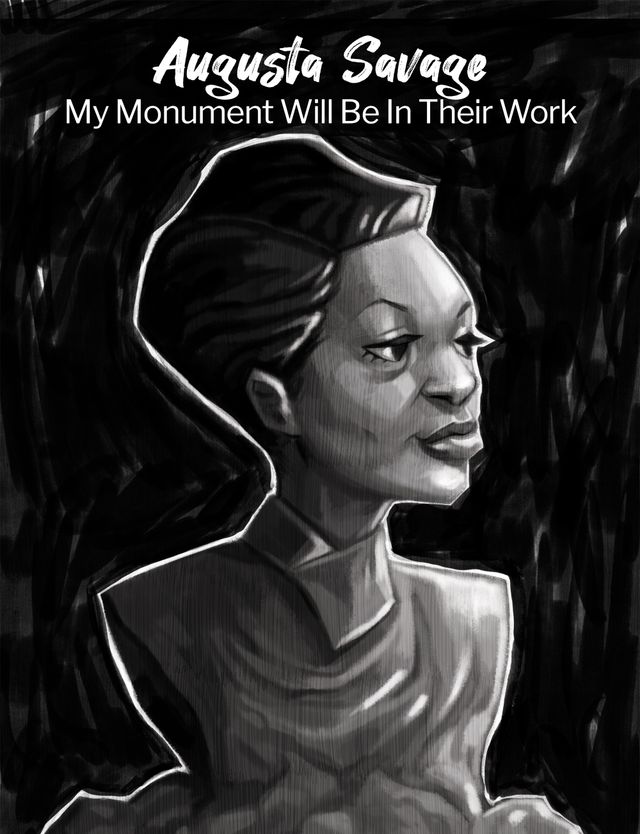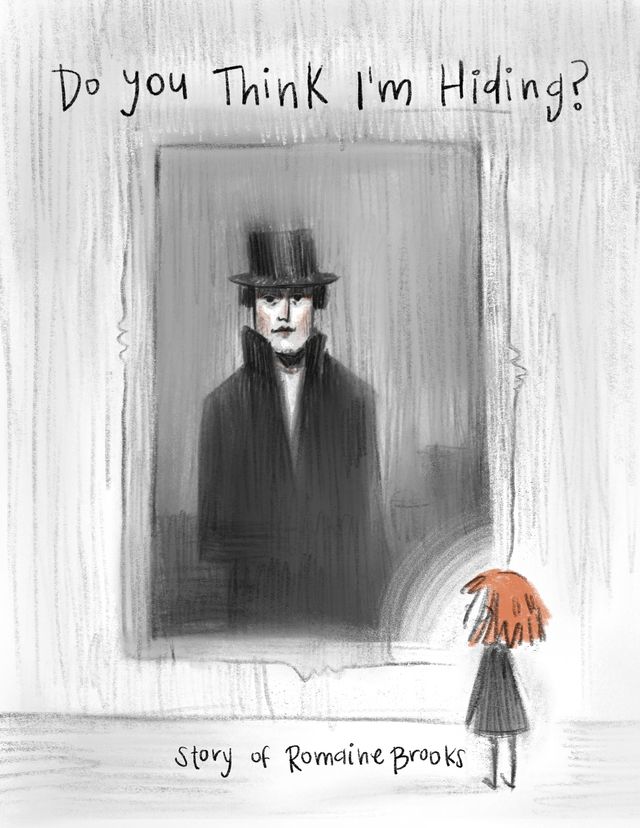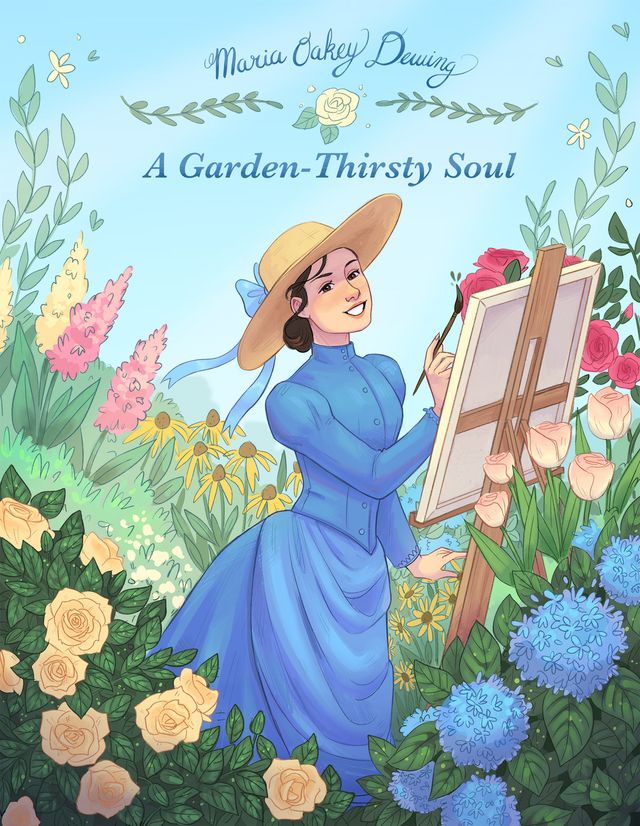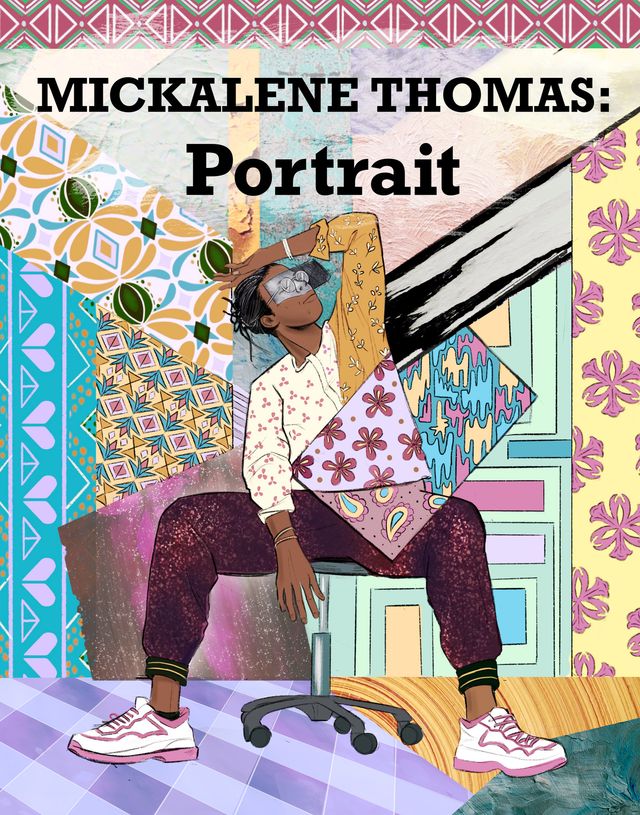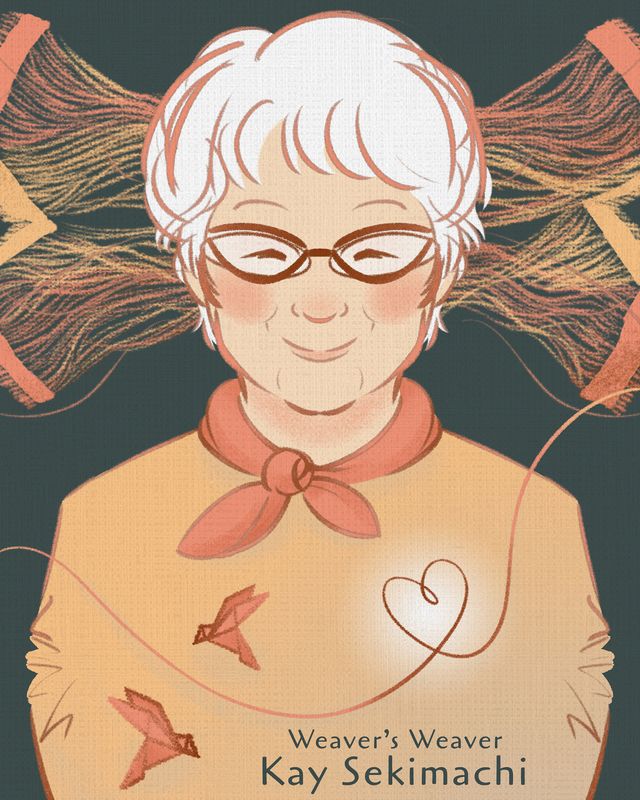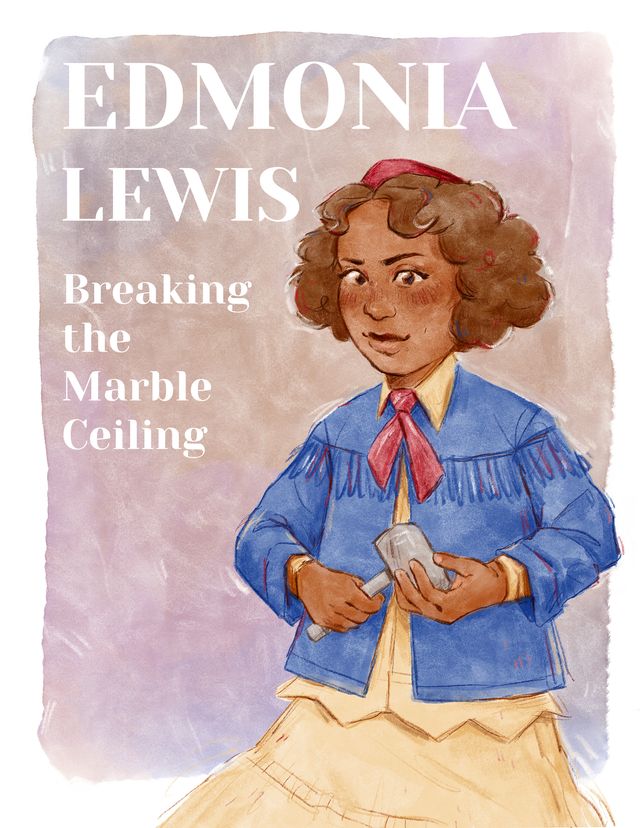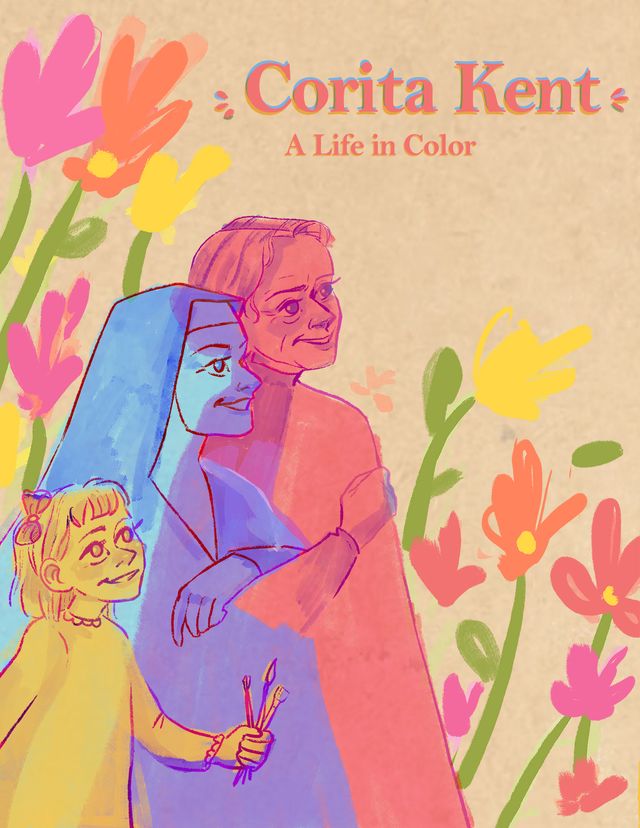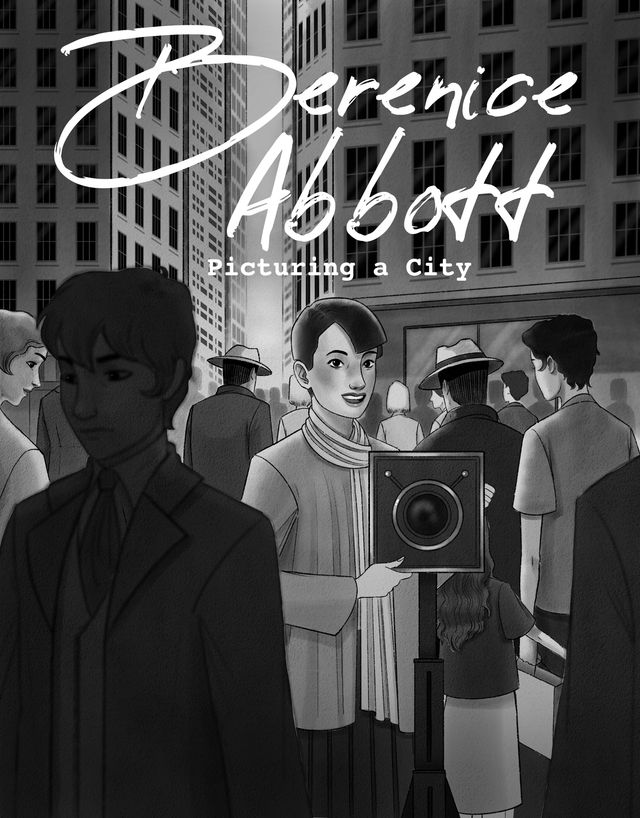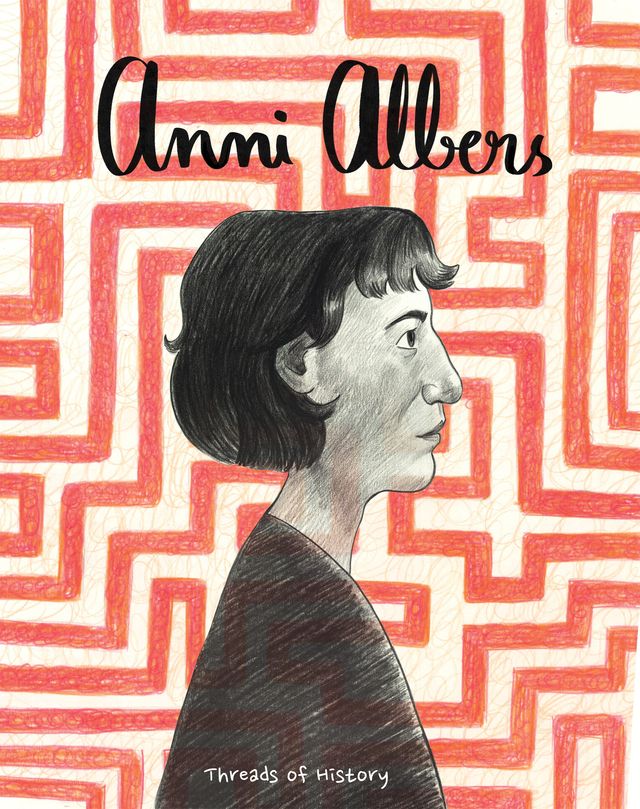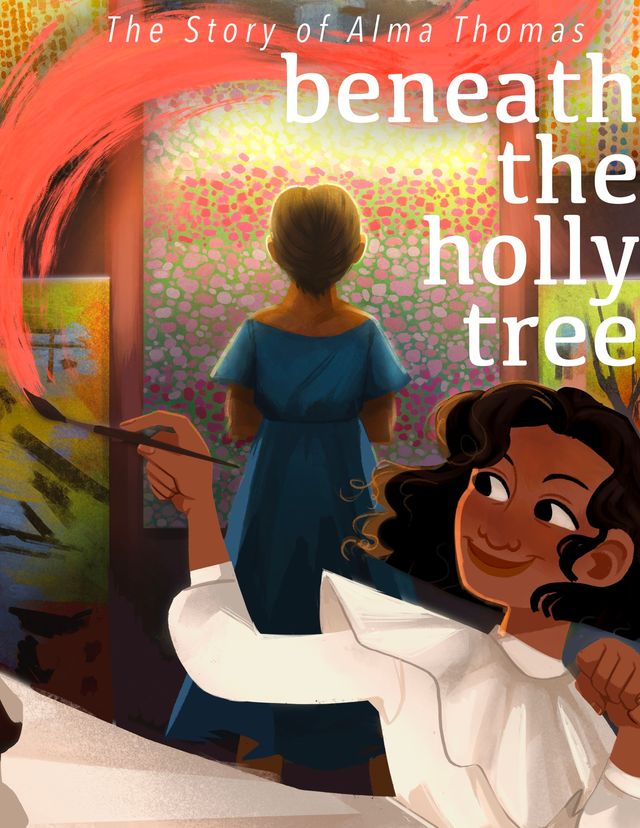An Overview
Wendy Red Star reassesses misconceptions around Native identity from a distinctly feminist, Indigenous perspective.
This comic is part of a series Drawn to Art: Tales of Inspiring Women Artists that illuminates the stories of women artists in the collection of the Smithsonian American Art Museum. Inspired by graphic novels, these short takes on artists’ lives were each drawn by a student-illustrator from the Ringling College of Art and Design.
We invite you to read the comic and share it with your friends and young people in your life.
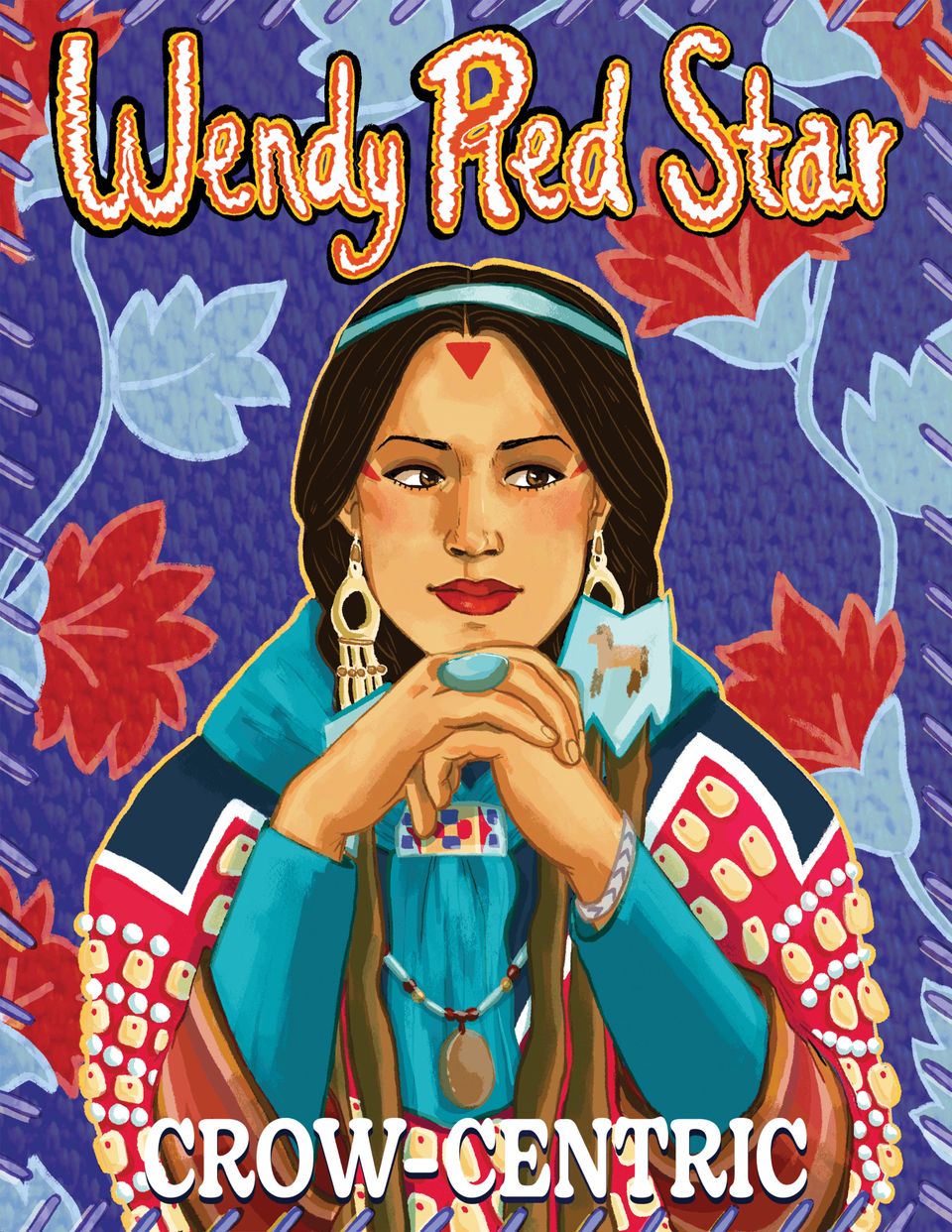
Cover
A woman with a medium light skin tone and long dark brown braided hair sits in the middle of the page. She is wearing a light teal headband and has geometric triangular red makeup on her forehead and the top of her cheekbones. She has long ornate tan earrings and teal hair pieces with horses embroidered on them. She is wearing a dark teal scarf draped around her shoulders that is clasped together on her chest with a colorful buckle. She is also wearing a teal, brown, and gold beaded necklace with a large brown pendant. A teal long-sleeve shirt peeks out under a brown, red, navy and white jacket with shells and beads stitched on in rows. She holds her hands up clasped in front of her under her chin. She has a large teal stone ring on her right hand and a woven purple bracelet on her left hand. She is smiling softly and looking to the right, with black eyeliner and bright red lipstick. Behind the woman is a purple woven background with red flowers and light blue vines. Light purple stitching goes around the border of the page over the floral designs. Black, yellow, red, and white textured text at the top of the page reads: "Wendy Red Star." At the bottom of the page in white font text reads: "Crow-Centric."
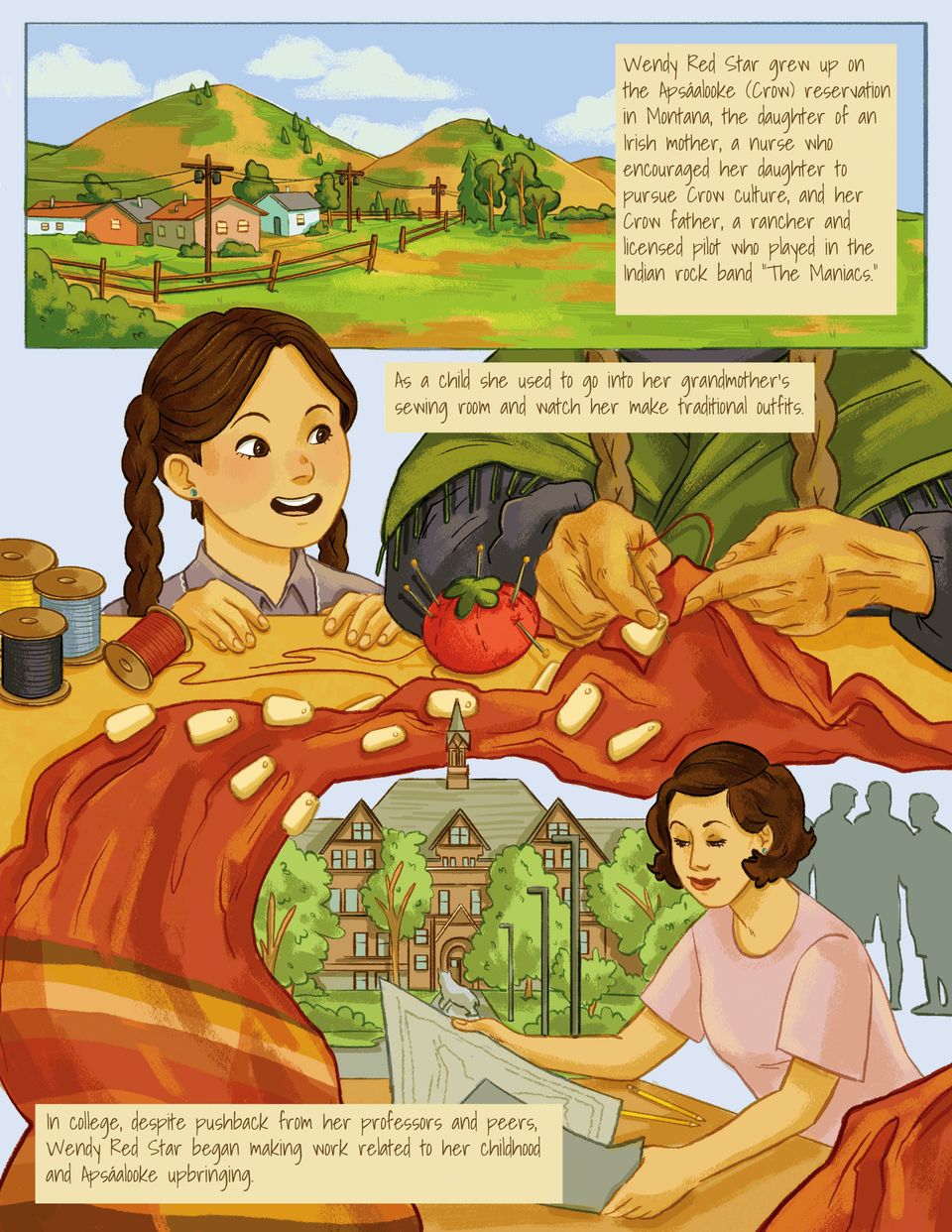
Page 1
Background: This page is made up of three panels, one at the top and one in the middle that overlaps with one at the bottom. The background is a solid light blue color. There are three yellow textboxes with black text.
Panel 1
The first panel shows a rural landscape. A large periwinkle sky with white fluffy clouds sits at the top of the page. On the left of the panel are large hills with golden and bright green patches and sporadic dark green trees. At the base of the hills is a settlement of colorful houses, surrounded by a simple wooden fence. A power line runs across the area of land within the fence. As the landscape moves to the right of the page it becomes less dense and is mainly a grassy field with a few green bushes and trees scattered throughout. A text box on the right side of the panel reads: "Wendy Red Star grew up on the Apsáalooke (Crow) reservation in Montana, the daughter of an Irish mother, a nurse who encouraged her daughter to pursue Crow culture, and her Crow father, a rancher and licensed pilot who played in the Indian rock band 'The Maniacs.'"
Panel 2
In the middle of the page is Wendy, a young girl, with dark brown hair in two braids. She is wearing circular teal earrings and a light purple collared shirt. She looks excitedly to her left, with her hands resting on the light wooden table in front of her. To her right is the torso of an older woman, with gray braids that rest on an olive-green shawl. The older woman is wearing a slate-colored balloon sleeve top and her medium skin toned hands sit in front of her, holding a piece of fabric, a needle, and thread. On the table in front of them are sewing supplies: four spools of thread to the left, a red pin cushion in the middle, and a long piece of burnt orange fabric flowing from the old woman's hands across the table and down into the third panel. This piece of fabric has white beads cascading down it, and the older woman is sewing more on. A text box at the top of the panel reads: "As a child she used to go into her grandmother’s sewing room and watch her make traditional outfits."
Panel 3
The long piece of burnt orange fabric from panel two flows down into the left side of panel three, with yellow and brown stripes along its edge. To the right of the fabric is a scene of a young Wendy leaning over a wooden table. She has chin-length brown hair and is wearing a light pink t-shirt. She is sitting facing the left of the page holding a piece of paper, with two pencils resting on the table in front of her. Behind her to the left is a large brown building with lots of windows and a central spire. The building is surrounded by large bright green trees and is sitting on a green lawn. A gray pathway winds its way to the front of the building, outlined by lampposts. To her right is a gray silhouette of three adults talking to each other. In the bottom left corner, a text box reads: "In college, despite pushback from her professors and peers, Wendy Red Star began making work related to her childhood and Apsáalooke upbringing."
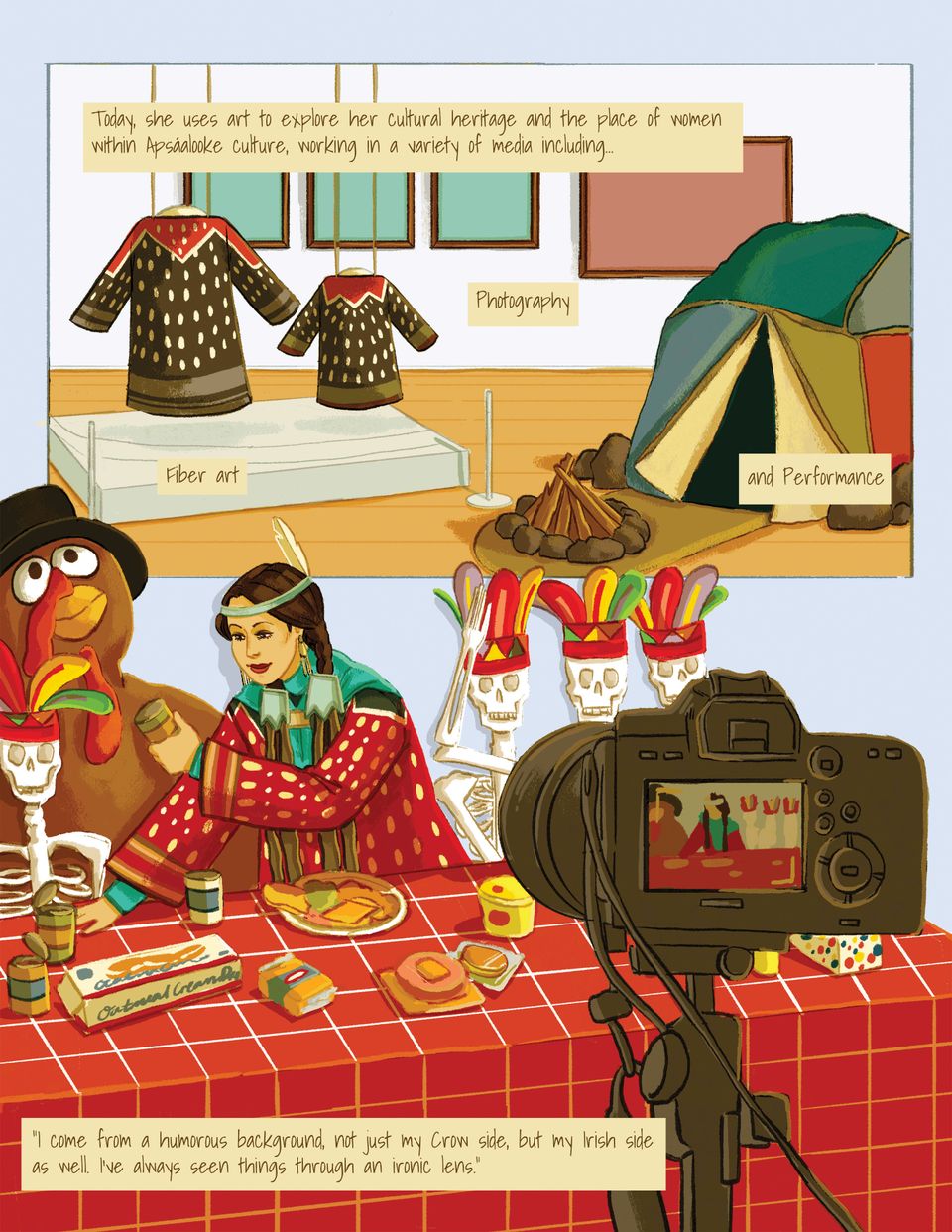
Page 2
Background: This page is made up of two panels, one at the top and one at the bottom of the page. There is one yellow textbox with black text that breaks into three smaller boxes at the top of the page, and one textbox at the bottom of the page. The background is the same light blue as the first page.
Panel 1
This panel shows a museum exhibit. There is a large white wall in the background with three teal paintings and one coral painting all in wooden frames. The foreground pieces sit on a light orange wooden floor. To the left there are two traditional brown and red Crow outfits with white polka dots. There is one for an adult and one for a child, hanging from the ceiling over a white base that is roped off. To the right of the panel is a colorful patchwork tent with flaps leading to an open entranceway and rocks circling the outer edge. In front of the tent is a tan base, on which a fire pit made of stones and logs sits. A text box at the top says "Today, she uses art to explore her cultural heritage and the place of women within Apsáalooke culture, working in a variety of media including…" Three smaller text boxes scatter across the page corresponding to the displayed artworks to finish the sentence saying "Photography," "Fiber art," and "and Performance."
Panel 2
This panel is a complex scene depicting Wendy as a young woman creating one of her photographs. In the foreground there is a black digital camera with a large lens facing away from the viewer, looking at the scene Wendy has created. In the screen on the back of the camera, the scene is repeated, with yellow focus lines on the edge. In the background of the panel but in front of the camera there is a long table covered by a red tablecloth with a white checkered pattern. On the table are a variety of packaged foods, including cans of vegetables, lunch meat, and Wonder Bread. A plate full of food sits in front of Wendy. She herself stands in the middle of the table, leaning over to the left of the panel while holding a can in her left hand reading its label. Her dark brown hair is in two braids, and she is wearing traditional Crow garb. She has a teal headband with a white feather in it, long gold earrings, teal hairpieces on each braid, and is wearing a long red dress with yellow beaded detailing and a bright turquoise long sleeve shirt and shawl. To the left of the page is a giant inflatable turkey wearing a top hat, with a Halloween skeleton leaning against it wearing a bright stereotypical "Indian" headdress. To the right of the page, three more skeletons all wear similar red, yellow, and green headdresses. A text box in the bottom left corner of the panel reads: "'I come from a humorous background, not just my Crow side, but my Irish side as well. I've always seen things through an ironic lens.'"
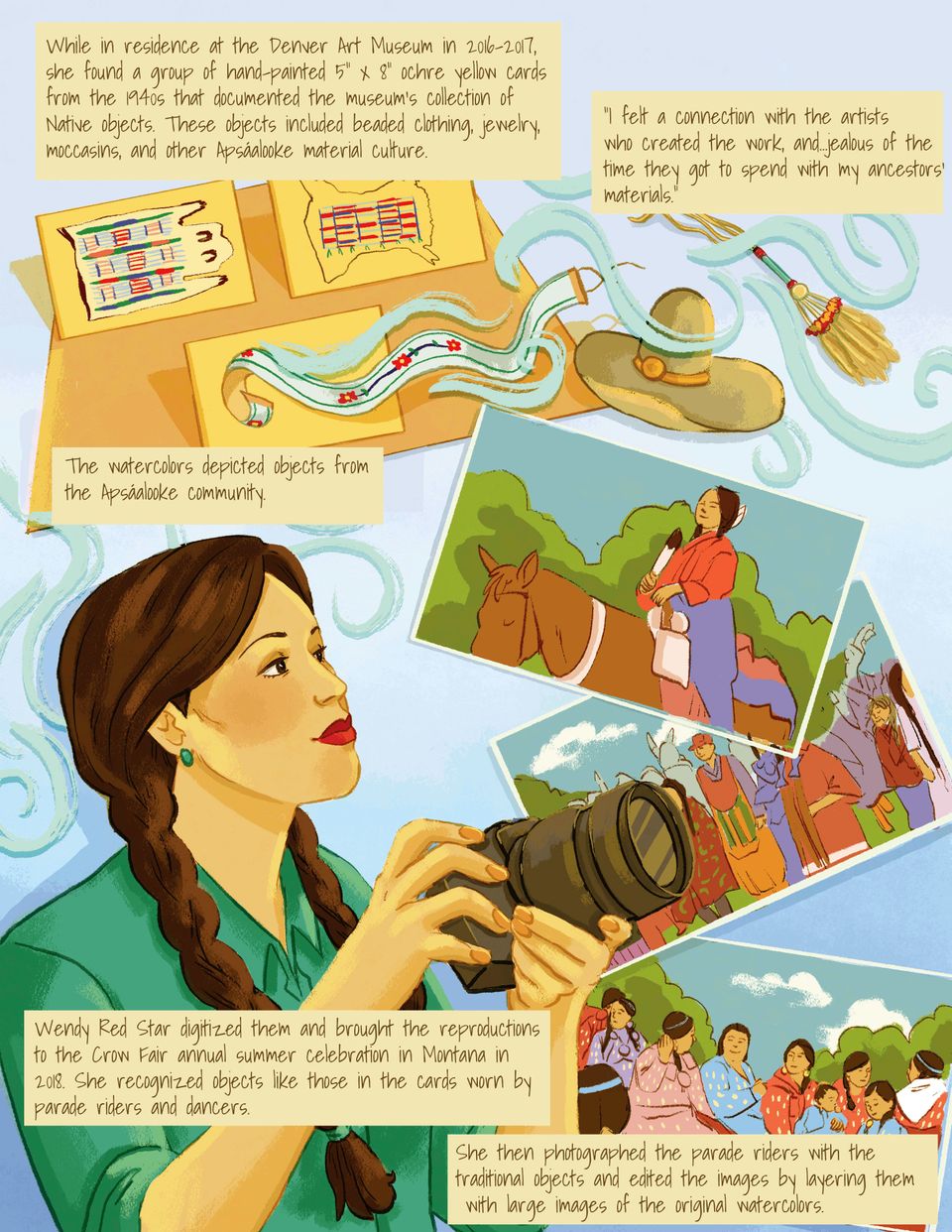
Page 3
Background: This page is one large panel with three overlapping sections. One section at the top, one in the bottom left and one in the bottom right of the page. The background of the page is the same light blue as the two before it. There are five yellow text boxes with black text.
The top of this page shows a collection of postcards sitting on a wooden base. There are three yellow postcards standing in a triangle formation, each with depictions of traditional Indigenous objects. Two of the cards have paintings of animal skins with colorful embellishments. The card closest to the viewer has a light teal Indigenous garment with red floral embroidery. The garment flows to the right off the page and into a teal gust of wind. Within this wind there is a wide brimmed tan hat with an orange decoration around the middle and a beaded piece of feather jewelry sitting to the farthest right of the page. A text box at the top left of the page reads: "While in residence at the Denver Art Museum in 2016-2017, she found a group of hand-painted 5" x 8" ochre yellow cards from the 1940s that documented the museum's collection of Native objects. These objects included beaded clothing, jewelry, moccasins, and other Apsáalooke material culture." Another text box to the right of the top half of the page reads: "'I felt a connection with the artists who created the work, and... jealous of the time they got to spend with my ancestors’ materials.'" A third text box sits on the edge of the wooden panel the cards sit on. It reads: "The watercolors depicted objects from the Apsáalooke community."
On the lower left half of the page an adult Wendy stands looking up to the right side of the page. She has long brown hair tied into two braids. She is wearing a bright-green long sleeve collared shirt, matching small circular earrings, and red lipstick. She is holding a black camera with a large lens at chest level, with her right hand on the shutter. Some of the teal wind from the above section flows behind her head and fades into the blue background. A text box over her shoulder and chest reads: "Wendy Red Star digitized them and brought the reproductions to the Crow Fair annual summer celebration in Montana in 2018. She recognized objects like those in the cards worn by parade riders and dancers."
On the right side of the page there are three printed photographs, overlapping down to the bottom right corner. The photo on top is of a Crow woman wearing red and purple traditional garb riding a brown horse. She is holding the saddle with her left hand and a feather with her right, and rides in front of large green trees and a blue sky. The photo below is partially obscured by the first photo and by Wendy's camera. There are many Crow people wearing traditional outfits in orange, purple, and red tones, standing and speaking together against a lush green background and a blue sky. The photo in the bottom right corner is also partially obscured, this time by Wendy's hand and the fifth text box. It shows a group of Crow women and children wearing pink, blue, purple, and red beaded dresses sitting and talking with one another. The same green trees and blue sky are behind them. A text box in the bottom right corner reads: "She then photographed the parade riders with the traditional objects and edited the images by layering them with larger images of the traditional watercolors."
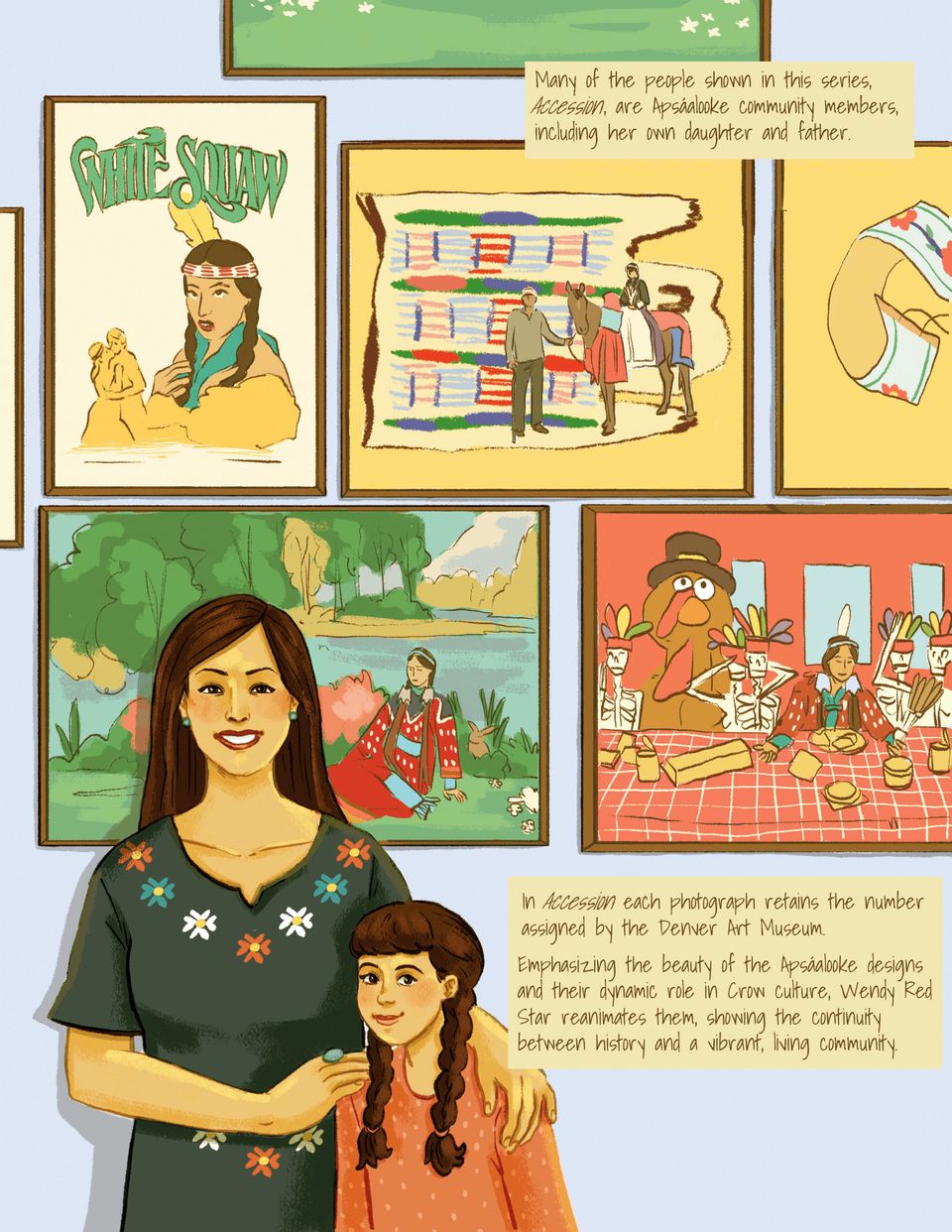
Page 4
Background: This page is one large illustration. There are two yellow text boxes with black text.
This page shows Wendy and her daughter standing in front of one of her exhibits . Wendy is standing and smiling at the viewer, with her long brown hair tucked behind her shoulders. She is wearing an army green short sleeved dress with orange, teal, and white flowers embroidered around the neck and waist. She has her left arm around the young girl next to her, and her right arm on the girl's left shoulder. The little girl has dark brown hair tied into two braids with bangs. She is wearing a long sleeve coral shirt with white polka dots and is smiling shyly at the viewer. Behind them, the background is a light blue wall with seven of Wendy’s works hung in a layered gallery wall. Five of the works are visible. On the top left is a print of Wendy acting as stereotypical trope of a native woman looking seductively at the viewer. Text at the top of the print reads: "White Squaw" in large green letters. In the top middle and top right are two of Wendy's Accession pieces which show photos of the Crow Fair layered on top of the yellow postcards she found in Denver. Obscured partially by Wendy’s head is her photo "Four Seasons Series (Spring)" that shows Wendy dressed in traditional Crow regalia laying in a picturesque landscape surrounded by faux flowers and grass. To the right is her piece "The Last Thanks" which shows Wendy in traditional garb surrounded by skeletons and an inflatable turkey sitting at a checkered table with processed food. All the pieces are framed in thin dark wood. A textbox in the upper right corner reads: "Many of the people shown in this series, Accession, are Apsáalooke community members, including her own daughter and father." A second text box in the bottom right corner reads: "In Accession each photograph retains the number assigned by the Denver Art Museum. Emphasizing the beauty of the Apsáalooke designs and their dynamic role in Crow culture, Wendy Red Star reanimates them, showing the continuity between history and a vibrant, living community."
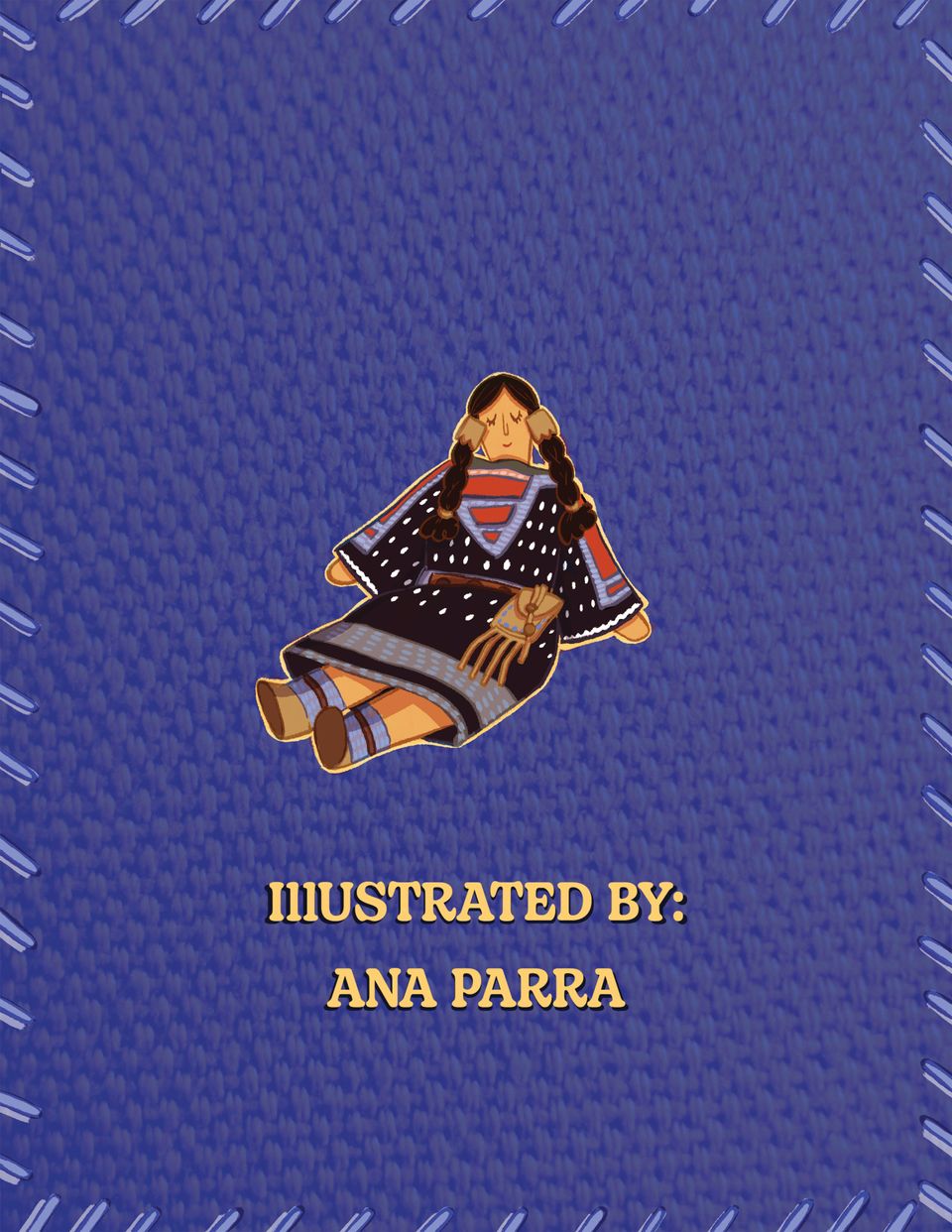
End page
A sewn doll sits against a woven dark purple-blue backdrop. Lighter periwinkle stitches border the page, making it look sewn together. The doll in the center is wearing traditional Crow regalia: a black, red, and periwinkle beaded dress and two long dark braids with tan hair accessories. Under the doll, yellow text reads: "Illustrated by: Ana Parra."














